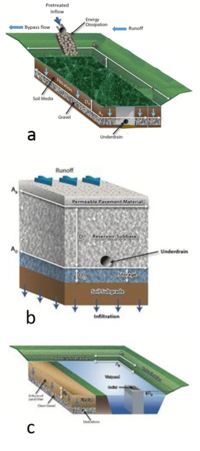
Category:Level 3 - General information, reference, tables, images, and archives/Tables/Filtration practices
Filtration best management practices (bmps) treat urban stormwater runoff as it flows through a filtering medium, such as sand or an organic material. They are generally used on small drainage areas (5 acres or less) and are primarily designed for pollutant removal. They are effective at removing total suspended solids (TSS), particulate phosphorus, metals, and most organics. They are less effective for soluble pollutants such as dissolved phosphorus, chloride, and nitrate. Their effectiveness for bacteria varies with bmp. Filtering practices include bioretention, permeable pavement, swales, media and vegetative filters, green roofs, filters strips, and some proprietary devices.
This page (Category) contains links to tables that provide information for filtration practices.
Pages in category "Level 3 - General information, reference, tables, images, and archives/Tables/Filtration practices"
The following 11 pages are in this category, out of 11 total.
F
S
This page was last edited on 2 August 2022, at 15:14.
